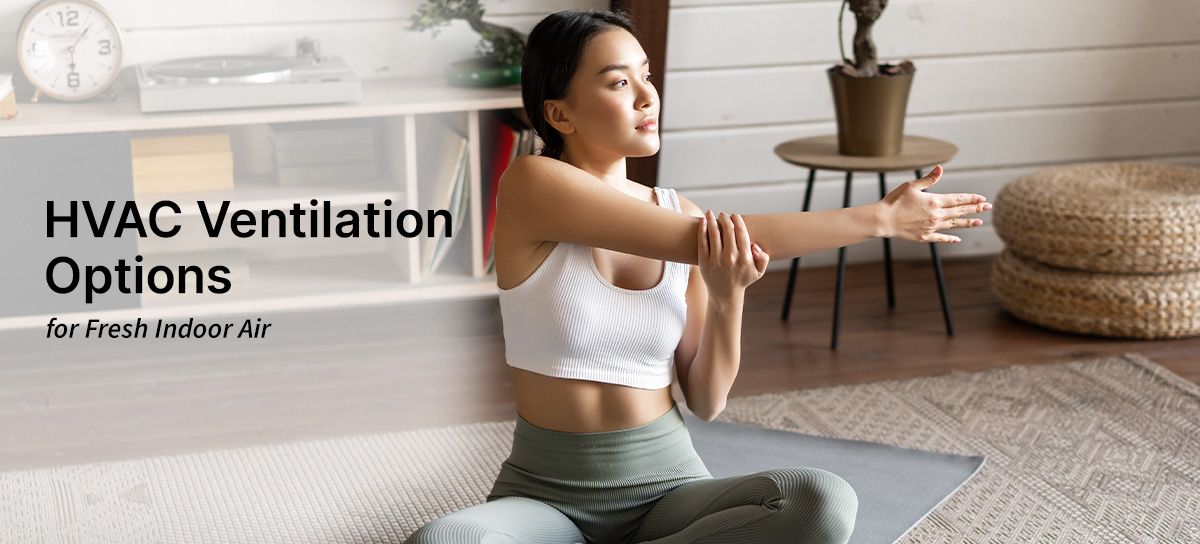
Did you know that, on average, we spend 90% of our time indoors?
Now, think about this: the air inside our homes can be up to five times more polluted than outdoor air. Take a deep breath. What have you just inhaled?
Indoor air quality isn't just about comfort — it's about your health and the well-being of your loved ones. Poor indoor air quality can lead to a range of health problems, including allergies, asthma, and even more severe respiratory illnesses. It can also affect your sleep quality, energy levels, and overall productivity.
It's time to take the air you breathe indoors seriously.
In this blog post, we’ll be taking a closer look at HVAC ventilation options to transform the air you breathe indoors. We'll share more about natural ventilation strategies, mechanical ventilation systems like HRV and ERV, the role of air filtration, and the benefits of whole-house ventilation.
We understand how this can seem daunting and overwhelming at best. We are here to support you through this process. Our highly skilled team is one phone call or email away, so don’t be afraid to reach out for any of your HVAC needs.
Indoor air quality (IAQ) refers to the condition or purity of the air inside buildings and structures, particularly in residential homes and workplaces. It includes various factors, including the presence of pollutants, the balance of humidity, temperature, and other indoor environmental elements.
There are many factors that can affect indoor air quality. Some of them include:
Prolonged exposure to poor indoor air quality can lead to a range of adverse health effects, including respiratory problems, allergies, cardiovascular issues, and even long-term chronic illnesses, creating a significant risk to the well-being of occupants.

Here are a few to keep in mind:
Now, let’s explore the various HVAC ventilation options available.
Natural ventilation refers to the process of using natural elements like wind and temperature differences to bring fresh outdoor air into a building and remove stale indoor air. The benefits of natural ventilation include energy savings, reduced reliance on mechanical systems, and the introduction of fresh outdoor air, which can improve indoor air quality.
Mechanical ventilation involves the use of mechanical systems (fans, ducts) to exchange indoor and outdoor air. Benefits include precise control over air exchange rates, improved air quality, and the ability to filter incoming air.
Air filters are crucial components of HVAC systems that capture and remove airborne particles and pollutants from the incoming air. They help reduce allergens, dust, bacteria, and other contaminants, improving IAQ.
Whole-house ventilation systems provide controlled and balanced air exchange throughout the entire building, ensuring fresh air in all rooms. Advantages include consistent air quality, reduced indoor humidity, and improved overall comfort.
Consider the following factors when choosing the right ventilation options for your specific circumstances. Taking them into account will help you make an informed decision that aligns with your building's size, climate, energy efficiency goals, and budget constraints.
Building size: Consider the size of your home or commercial space. Larger buildings may require more robust ventilation systems to ensure adequate air exchange.
Layout: Evaluate the layout of your space, including the number of rooms and their accessibility. Some ventilation options may be more suitable for open floor plans, while others work well in compartmentalized spaces.
Climate: The local climate plays a significant role in ventilation needs. In hot and humid climates, you may need strategies that help control indoor humidity, while in cold climates, heat recovery options like HRVs may be preferred.
Outdoor air quality: Assess the outdoor air quality in your area. If outdoor air is heavily polluted, you may need more robust filtration or ventilation solutions to ensure the air brought indoors is clean.
Consider the energy efficiency of ventilation options. Some systems, like HRVs and ERVs, can recover heat or energy from outgoing air, reducing overall energy consumption.
Look for energy-efficient models and systems that meet your ventilation needs without significantly increasing your energy bills.
Determine your budget for ventilation improvements. Some ventilation systems can be more expensive, but they may offer long-term energy savings and improved air quality. When determining your budget, be sure to factor in installation costs, maintenance expenses, and any potential rebates or incentives available for energy-efficient ventilation systems.
Regular maintenance can also identify and address issues such as mold growth, leaks, or malfunctioning components that can impact IAQ.

Monitoring IAQ allows you to track changes over time and take corrective actions when needed, such as adjusting ventilation rates or activating air purification systems.
Consider combining different ventilation options for comprehensive air quality improvement.
For example, you can pair mechanical ventilation systems like HRVs or ERVs with air filtration systems to filter incoming air while recovering energy from exhaust air. Whole-house ventilation can complement natural ventilation strategies to ensure consistent air exchange throughout your space.
We understand how this can seem daunting and overwhelming at best. We are here to support you through this process. Our highly skilled team is one phone call or email away, so don’t be afraid to reach out for any of your HVAC needs.
